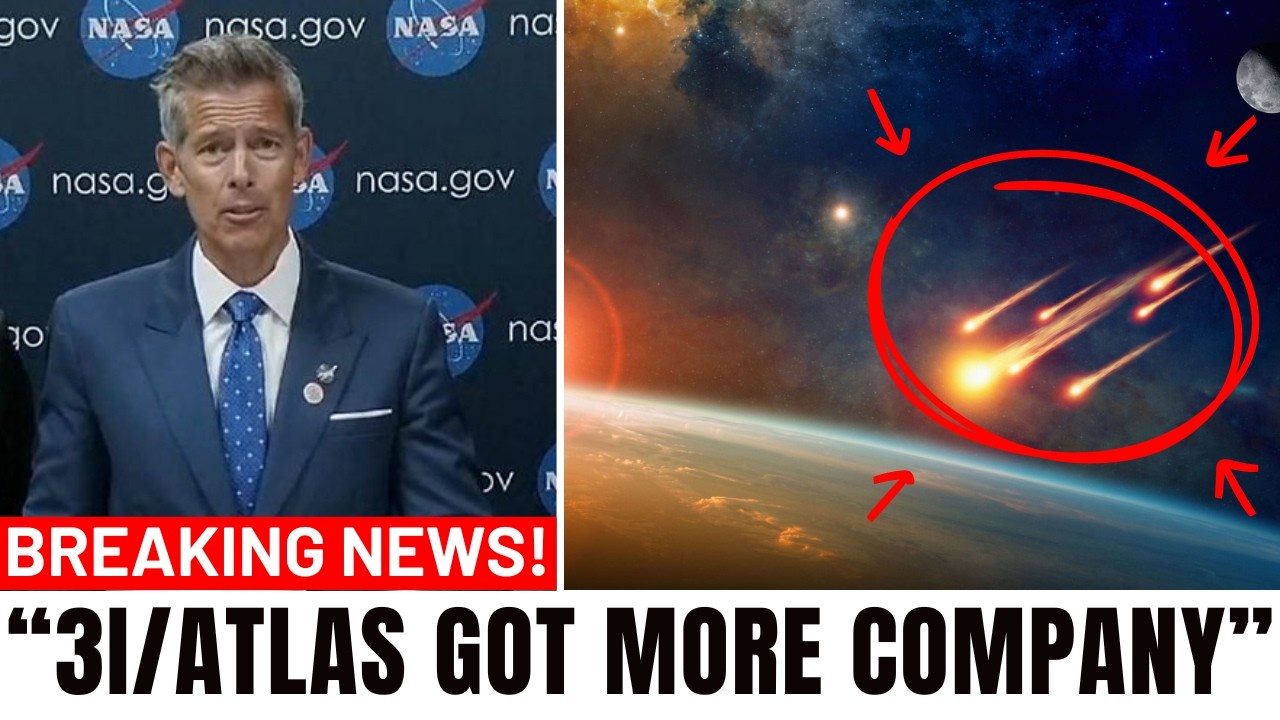🚨 NASA’s scrambling: A swarm of seven icy intruders is plunging toward our solar system—led by the interstellar beast 3I/ATLAS that’s suddenly ballooning with a bizarre green glow… ❄️🌌
Is this a cosmic light show or the vanguard of something engineered? Telescopes clocking exponential growth, tails stretching like warnings, and trajectories too synced to be chance. Alien seeds? Doomsday dive? The clock’s ticking to perihelion—don’t miss what happens next.
What cosmic secret would shatter your world? Unpack the frenzy:

NASA’s planetary defense teams are ramping up observations as a cluster of seven comets—including the rare interstellar object 3I/ATLAS—barrels into the inner solar system, with the lead comet displaying anomalous brightening and structural changes that have astronomers buzzing. Dubbed a “swarm” in viral videos and social media posts, the group poses no immediate threat to Earth but offers a rare chance to study multiple icy wanderers in close succession. The heightened activity around 3I/ATLAS, which recent images show expanding with a striking blue-green coma and elongated tail, has fueled speculation from Harvard’s Avi Loeb about potential non-natural origins, though agency officials stress it’s a natural phenomenon amplified by solar heating.
The interstellar comet 3I/ATLAS, discovered on July 1, 2025, by the NASA-funded Asteroid Terrestrial-impact Last Alert System (ATLAS) telescope in Chile’s Río Hurtado observatory, is the third confirmed visitor from beyond our solar system, following ‘Oumuamua in 2017 and Borisov in 2019. Initially classified as a potential asteroid due to its lack of immediate cometary features, follow-up observations revealed a faint coma and tail, confirming its icy nature. Traveling at a blistering 130,000 miles per hour— the fastest recorded for any solar system interloper—3I/ATLAS originated from the direction of Lyra and is on a hyperbolic trajectory that will sling it past Mars on October 3, reach perihelion (closest to the Sun) on October 29-30 at 1.36 AU (about 126 million miles), and exit toward the Milky Way’s outer edges by early 2026. Its closest approach to Earth comes December 19 at 1.8 AU (170 million miles), far enough to rule out any collision risk.
What has NASA on high alert isn’t 3I/ATLAS alone, but its timing amid a flurry of other comets converging in late 2025. YouTube channels like Megatrends New and Cosmic Atlas have popularized the “swarm” narrative, highlighting seven objects: 3I/ATLAS, C/2025 R2 (SWAN)—a sungrazing comet discovered September 12 via NASA’s Solar and Heliospheric Observatory (SOHO)—C/2025 A6 (Lemmon), and four others including periodic returnees like 12P/Pons-Brooks and newcomers from the Oort Cloud. C/2025 R2 (SWAN), nicknamed SWAN25B, is already visible with binoculars near Mars in the evening sky, sporting a 2.5-degree tail that’s five full Moons long and brightening to potentially naked-eye visibility by mid-October. Meanwhile, C/2025 A6 (Lemmon), spotted in January by Arizona’s Mount Lemmon Survey, will graze Earth’s orbit at 0.60 AU on October 21—the same day as SWAN’s closest pass—setting up a double-comet spectacle alongside the Orionids meteor shower.
The “swarm” label, while dramatic, stems from the unusual clustering: astronomers typically spot one or two bright comets per year, but 2025’s solar maximum—peaking with intense flares like the X-class eruptions from sunspot AR4087 in May—has stirred up Oort Cloud ejecta, sending more icy bodies inward. NASA’s Planetary Defense Coordination Office, in its September update, noted no hazardous near-Earth objects among them but emphasized coordinated tracking via the Minor Planet Center to refine orbits. “These events are exciting for science, not alarm,” said NASA’s Thomas Statler in a statement to The Debrief, countering online hype. “3I/ATLAS is a comet—its growth is classic sublimation as it nears the Sun.”
Yet 3I/ATLAS’s evolution has defied easy categorization. Hubble’s July 21 image pegged its nucleus at 3.5 miles (5.6 km) across—larger than initial estimates—with a reddish dust cocoon but no prominent tail. By late August, Gemini South’s deep-field exposures on August 27 revealed a glowing coma and prominent tail, with colors indicating organic-rich tholins and elevated carbon dioxide (8:1 ratio to water ice, per James Webb Space Telescope data from August 6). Then, in mid-September, astrophotographers Gerald Rhemann and Michael Jäger captured a blue-green gas coma spanning 2.5 arcminutes during the September 7 lunar eclipse— a hue typically from dicarbon (C2) molecules, but JWST spectra show scant C2, puzzling experts. “It’s growing faster than models predict,” noted Michigan State University’s lead researcher in a September 11 Astrophysical Journal Letters paper, which uncovered pre-discovery TESS images from May 2025 showing early activity. The Very Large Telescope detected cyanide and nickel vapors akin to solar system comets, but the object’s dry, CO2-heavy makeup suggests origins in a distant system’s thick disk—potentially 7 billion years old.
This “growth”—referring to the expanding coma and tail as ices vaporize—has reignited fringe theories. Avi Loeb, Harvard’s Galileo Project founder, blogged on September 18 that the luminosity (gigawatts) and precise trajectory (1-in-20,000 odds for planetary flybys) could indicate a nuclear-powered probe, echoing his ‘Oumuamua light-sail hypothesis. On X, posts from @mojustinX and @Isaac_A_Arthur amassed thousands of views, with Isaac Arthur’s YouTube video “Is 3I/ATLAS an Alien Artifact?” hitting 50,000 plays in days. Conspiracy accounts like @PatrickQJackson tied it to UAP disclosures, claiming Grok-4 analyses show “non-random” maneuvers, while @bite_pig11605 warned of a “slingshot to Earth.” Loeb rates artificial odds at 40%, urging rapid-response missions, but concedes natural explanations dominate.
NASA’s multi-mission net is casting wide. ESA’s Mars Express and ExoMars Trace Gas Orbiter will image 3I/ATLAS during its October 3 Mars flyby, using spectrometers for gas composition. At Jupiter in March 2026, ESA’s Juice—already en route to icy moons—may snag tail samples with its particle sensors. NASA’s SPHEREx, fresh from its 2025 launch, mapped 3I/ATLAS’s ices in August, while Psyche and Lucy missions could opportunistically observe from afar. For the swarm, SOHO and STEREO-A will monitor sungrazers like SWAN R2, which peaks October 19 at 0.25 AU from the Sun, potentially fragmenting in a fiery display. Ground-based assets like the Vera C. Rubin Observatory, gearing up for 2026, are primed for real-time tracking.
Social media frenzy mirrors past comet panics, like Hale-Bopp in 1997. X threads from @AstronomyVibes and @the_odd_log blend facts with fiction, with @romanov_filipp sharing fresh iTelescope images from September 18 showing the tail’s arcsecond elongation. Users like @patriotmome link it to prophecies, citing “Seven Heralds” in QAnon drops, while @ctgsecurity tags Elon Musk for insider scoops. Debunkers, including @Science24x7, pivot to science: “Forget spacecrafts—3I/ATLAS could be a planet-forming seed from another system.” Community notes flag hoaxes, like claims of “catastrophic disclosure.”
Experts like Northeastern’s Jacqueline McCleary see opportunity over alarm: “3I/ATLAS’s CO2 dominance hints at diverse planetary nurseries—8:1 ice ratios unseen here.” Planetary Society’s Bryce Bolin, who studied all three interlopers, told Planetary Radio in August that pre-discovery June 14 images from Zwicky Transient Facility reveal it crossed the galactic center undetected, underscoring detection challenges. As the swarm converges, October’s skies promise aurora-like tails and potential meteor bursts—SWAN25B may spawn a shower around October 5.
Skeptics in outlets like BBC Sky at Night call the growth “outgassing 101,” attributing the green glow to undetected C2 or solar fluorescence. The Guardian’s August piece labeled it a “fun space rock,” downplaying alien talk. Still, with Rubin online soon spotting thousands annually, 2025’s cluster signals a new era of cosmic traffic. Loeb’s Galileo Project pushes for intercepts—SpaceX Starship studies outline nuclear propulsion chases—but time’s short for 3I/ATLAS.
As 3I/ATLAS fades from view post-September—reemerging December 2025 with possible flares—the swarm reminds us: space is alive with transients. Natural or not, these dives peel back layers of the universe’s history, from 7-billion-year-old disks to Oort ejections. NASA’s vigilant, telescopes locked— the data will decide if it’s spectacle or signal.





